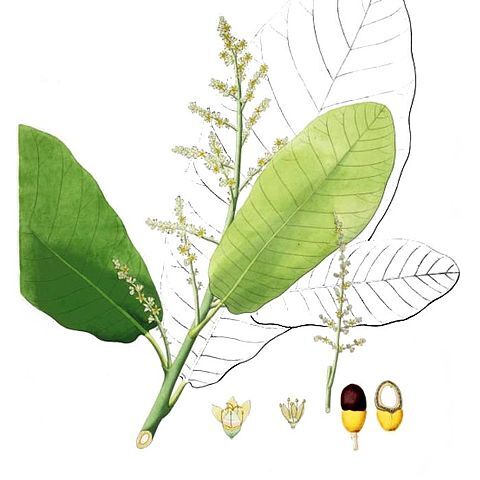Trees, sometimes treelets or shrubs, rarely unbranched (S. magnificus, rarely in S. curtisii, S. bunburyanus). Leaves simple, spiral or alternate, sometimes subverti-cillate, entire, often papillose on the lower surface, petioled. Inflorescences terminal and/or axillary, rarely cauliflorous, paniculate, rarely raceme-like; pedicels articulated, sometimes at the base. Flowers unisexual or rarely bisexual (plants dioecious or rarely polygamous), ♀ ones usually larger than the ♂. Calyx 5-(or 4-)lobed. Petals 5 (or 4), imbricate, or rarely valvate. Stamens 5 (or 4); filaments subulate, glabrous; anthers dorsifixed. Imperfect or sterile stamens in ♀ similar to fertile ones but (much) smaller and shorter. Disk intrastaminal, round, flat (or slightly convex above), shallowly dish-shaped, short-cupular (or rarely funnel-shaped), often 5-(or 4-)notched, usually hairy above, sometimes glabrous (except sometimes the central part or rudimentary pistil in ♂). Ovary superior, 1-celled, usually densely hairy, glabrescent, rarely glabrous; styles 3, often hairy near the base, terminal, divergent; stigma transverse-oblong or subreniform. Rudimentary pistil in ♂ minute or 0, or replaced by a tuft of hairs. Drupe 1-celled, often laterally compressed, seated on a distinct, fleshy hypocarp (formed by the calyx and floral axis) which is sometimes cupular whereby the fruit is seemingly slightly semi-inferior; exocarp and mesocarp fleshy, loaded with acrid resin; endocarp crustaceous. Seed with testa free from the endocarp; embryo straight; cotyledons free, plano-convex.
More
Trees or shrubs, dioecious, rarely polygamous. Leaves simple, alternate, entire, often minutely papillose on abaxial surface. Inflorescence terminal and/or axillary; pedicels articulate. Calyx 5-lobed. Petals 5, usually imbricate. Disc intrastaminal. Male flowers: stamens 5, alternating with petals; filaments subulate, glabrous; anthers dorsifixed; pistillode present. Female flowers: staminodes present; ovary superior, 1-locular with 1 ovule; styles 3, divergent; stigmas transverse-oblong or subreniform. Fruit a drupe, 1-locular, often laterally compressed, on or immersed in fleshy hypocarp formed by calyx and floral axis. Exocarp and mesocarp fleshy, resinous; endocarp crustaceous. Seed testa free from endocarp; embryo straight; cotyledons free, plano-convex.
Inflorescence paniculate, terminal or axillary. Stamen filaments linear; anthers ovate-cordate, versatile. Disk cup-shaped. Ovary superior to semi-inferior, 1-locular and 1-ovulate; styles 3, free or united basally. Drupe ovate-globose, inserted on an inflated hypocarp formed by fused calyx and floral receptacle. Seed testa not fused with endocarp.
In primary forest at low and medium altitude, sometimes occurring in montane forest up to 1950 m, and occasionally found in periodically inundated regions or peat-swamp forest, monsoon forest, teak forest, or secondary forest, on limestone hills, or in ultrabasic areas.Most species belong to the middle storey or attain the subcanopy, but some do not go beyond the lower storey, or are even small and unbranched (spp. 1 & 2) cycadoid and large-leaved. Of several spp. (13, 14, 27, 30) it is recorded that their twigs are hollowed and inhabited by ants, but the myrmecophilous habit is not compulsory for the plant.

